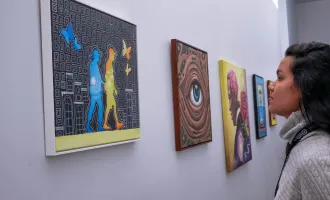
On the Road with Bashō: Exploring Art with a Haiku Virtuoso and Literarily Immortal Novelist, Part One
Without question, Dany Laferrière’s new novel, Sur la route avec Bashō, French for “On the road with Bashō,” constitutes a fanciful and poetic manuscript. In embodying a perspective-shifting, and penetrating, œuvre d’art, or artistic creation, it substantiates its worthiness of prompt enjoyment, regardless of one’s spoken language. Furthermore, the manuscript serves as a vast, and eclectic, pocket-book museum, in presenting in book form a collection of paintlike drawings, as part of a cultural artifact referred to as an artists’ book.
Using colorful art pieces to transcend written language’s sensory and conceptual limits, Laferrière abandons semantic, for visual, processing, with the uplifting aim of inviting unbounded immersion into contemplative, lived experience aesthetics.
Penned and illustrated by the literarily-immortal academician himself, this cross-culturally accessible book rounds off a 1220-page collection of pictorialized, and genre-transgressive, works conceived throughout the past demi-decade.
As part of a multi-piece series, this article will primarily explore select themes accentuated by Sur la route, while offering four archetypal excerpts from the novel. Simultaneously, this work will also present four pieces of its own imaginative art, as part of an exercise in subjective interpretation anchored in rapt dissection and aesthetic indulgence.
In starting off, while discussing his source of inspiration for Sur la route, Dany explains how, 15 or so years ago, he was, at a friend’s house, casually socializing. While there, the novelist, the author of 35 books and holder of at least five honorary doctorates, stumbled upon The Narrow Road to the Deep North —a magnifique, or wonderful, book composed by Matsuo Bashō (松尾 芭蕉), originally entitled Oku no Hosomichi (おくのほそ道) —or Le Chemin Etroit Vers les Contrées du Nord in French.
In Oku no, Laferrière subsequently read about one of Bashō’s leisurely trips, taken by foot, by the staff-wielding, seventeenth-century Japanese monk-poet, alongside his disciple, Sora, to watch the sunset. Bashō’s description of his journey, alongside Oku no’s prose and scattered poems, struck Dany to such an extent that the Haitian-Canadian brainbox and creative decided to follow in the footsteps of the preeminent poet, who, in many respects, headed Japan’s 17th-through-19th-centuries Edo period (江戸時代, Edo jidai).
Before introducing readers, and viewers, to the creator’s artistic productions, Laferrière’s Sur la route highlights the aim of its author’s imaginative globetrotting —oriented toward capturing “only those flickering images,” or « que ces images tremblotantes », behaving “like grains of dust dancing in the morning light.” Thereafter, the book attempts to draw some parallels.
In so doing, the work attempts to juxtapose the literary and artistic practices of the Haitian novelist and Japanese poet, as musing adepts, who lived and experienced the world two-and-a-half centuries, and thousands of miles, apart.
In marveling at the doyens’ pensive, if not dreamy, lives, one might initially wonder how, ever, could the two journey together, and what they could, or would, say to one another. In grappling with such questions, the book’s back cover argues that “If Bashō makes landscapes speak” (« Si Bashō fait parler le paysage »), “Laferrière interrogates faces, or appearances” (« Laferrière interroge les visages »). And despite the partly divergent foci of their œuvres, or bodies of work, some crucial, if not contrastive, commonalities persist at the heart of the two littérateurs’, or writers’, relationships.
More precisely, Sur la route argues that shared existential, or lived experience, as well as tendential, or preference-based, qualities prevail between Bashō and Laferrière. According to the book’s back cover, or « quatrième de couverture », “What connects,” the two authors is, at least, their joint identity as islanders (« insulaires ») —or, more equivalently, as “insularies,” in archaic English. And, respectively, as Asian and Caribbean islanders, Bashō and Laferrière know “how to dance on a land that trembles,” alongside the two thinkers’ possession of “this immoderate taste for tiny things.” At a fundamental level, however, alongside their shared qualities, some points of difference can be found between the two littérateurs.
A primary contrast entails Bashō’s and Laferrière’s divergent sources of inspiration. Whereas “Bashō is a contemplative who does not hesitate to cross Japan to watch the sunset,” basking in nature’s splendor, “Laferrière’s universe is chaotic, urban, and oppressive,” casting and recasting literary shadows on familiar and modern tropes.
The book ends its comparison and contrast of the two wordsmiths through additionally distinguishing Laferrière’s artistic novel from the work of acclaimed, 20th-century writer Jack Kerouac.
Born Jean-Louis Lebris de Kérouac, in a French-Canadian, Massachusettsan home, Kerouac was an American novelist, and poet, who inspired countless pop culture icons, like well-known singer-songwriter Bob Dylan, English rock band The Beatles, as well as American musicians, like The Doors’. Of noted significance is the fact that Kerouac authored On the Road, a highly-celebrated, 1957 roman à clef.
On top of being well-read by members of the postwar Beat and Counterculture generations, Kerouac’s On the Road recounts the deeds and lives of central characters living within a sociocultural milieu, defined by an appreciation for jazz, drug use, and poetry. “It is not surprising then,” per Sur la route’s back cover, “that between Kerouac, with whom he shares an America of speed, and Bashō, who travels at the pace of a snail on the narrow roads of the districts of northern Japan, [Laferrière] chose to travel with Bashō.” And whereas Kerouac’s novel concerns traveling across the U.S., Laferrière’s journeying in Sur la route is fundamentally international, in terms of its outlook.
Therefore, unlike Kerouac, Laferrière portrays experiences, people, movements, and ideas encountered across North America, the Caribbean, Europe, and Asia. And countries serving as the settings of the novel’s artistic works encompass the U.S., Haiti, Canada, France, Japan, China, South Korea, Russia, Italy, Germany, and beyond.
At long last, envisaging, and artistically modeling, Laferrière’s cosmopolitan journeying with Bashō, and the poet’s haikus, is this essay’s first illustration —depicting, above, a walk imaginatively shared by this piece’s author and the two littérateurs. Therein, a slow-paced, short-lived journey transpires, as the three thinkers explore Japan’s countryside.
Ultimately, in elevating a seemingly mundane activity, like walking, this piece’s central theme intersects with Bashō’s unfading suggestion that “every day is a journey, and the journey itself home.” Additionally, according to Laferrière, in Sur la route, one can come to “view the same thing through a different angle” (« Revoir la même chose sous un nouvel angle »), by walking, experiencing everyday life, and appreciating Nature’s aesthetics.



